Wednesday, January 31st
A field season approaches like Christmas morning and the start of a school year. There is planning, organizing, restocking supplies, and the contagious excitement of what the season will bring.
January 31st marks the start of the 2024 field season. I think that a herd of flying cows would be less alarming than walking the pond site last week. The picture shows the path around the pond and this path has always been snow-covered and under water until roughly April 1st. The path cuts between the pond and a stream, which becomes one body of water in the winter through spring thaw.
This is a storm water pond. It was built when Haas Dog Park was built to address flooding. The pond houses two species of frog, multiple species of Odonata (damselflies and dragonflies), and an assortment of other aquatic life.
At this rate, it could dry out this year.
January 31st marks the start of the 2024 field season. I think that a herd of flying cows would be less alarming than walking the pond site last week. The picture shows the path around the pond and this path has always been snow-covered and under water until roughly April 1st. The path cuts between the pond and a stream, which becomes one body of water in the winter through spring thaw.
This is a storm water pond. It was built when Haas Dog Park was built to address flooding. The pond houses two species of frog, multiple species of Odonata (damselflies and dragonflies), and an assortment of other aquatic life.
At this rate, it could dry out this year.
Wednesday, April 10
Anxiously awaiting the dragonflies, I take pictures of everything. It has paid off because I have accumulated a body of phenology records, which could prove useful when the weather does bizarre things.
Water striders (Gerridae) are a family of true bugs (order Heteroptera). They are one of the first insects active at my research sites.
They are predatory and 90% live in freshwater.
Wednesday, May 1
The weather has not been cooperative for surveying. I have used the excitement for the field season to catch up on household chores and plan for the year.
The constant rain over the last couple of weeks has helped the pond recover water that should have been snow melt. The little land bridge is a welcome soggy under my feet.
No dragonflies. Just more clouds and rain.
Monday, May 6
The story of Red-winged Blackbirds (Agelaius phoeniceus) is the story of dragonflies. Red-winged Blackbirds are one of the first migrants to arrive in the spring and the Common Green Darners are not far behind them.
Females are less colorful and hide well in the cattails, catching emerging Odonata (dragonflies and damselflies), other insects, and arachnids. The male is the sentry, guarder of the nest, sporting a red patch on the wings. He is the reason I contemplated wearing my hockey helmet last summer.
A baby dragonfly is a fierce little creature, a water bound terror. All Odonata have a water life stage, which can last up to five years depending on the species and environmental conditions. Today I scooped creatures out of the pond and placed them in a wash bucket, watched them move around, then returned them to the pond. This is an easier process in the spring because the net does not gather as much mud, making animals easier to find. I captured a baby dragonfly and named them Dennis, who made the survey more eventful than usual.
Pond Survey Inventory
1.) Dragonfly nymph (Dennis)
2.) Dragonfly nymph (not Dennis)
3) Damselfly nymph
4.) Mosquito larvae
5.) Class Gastropod
6.) Genus Gammarus
7.) Not pictured and unknown (Dennis got hungry)
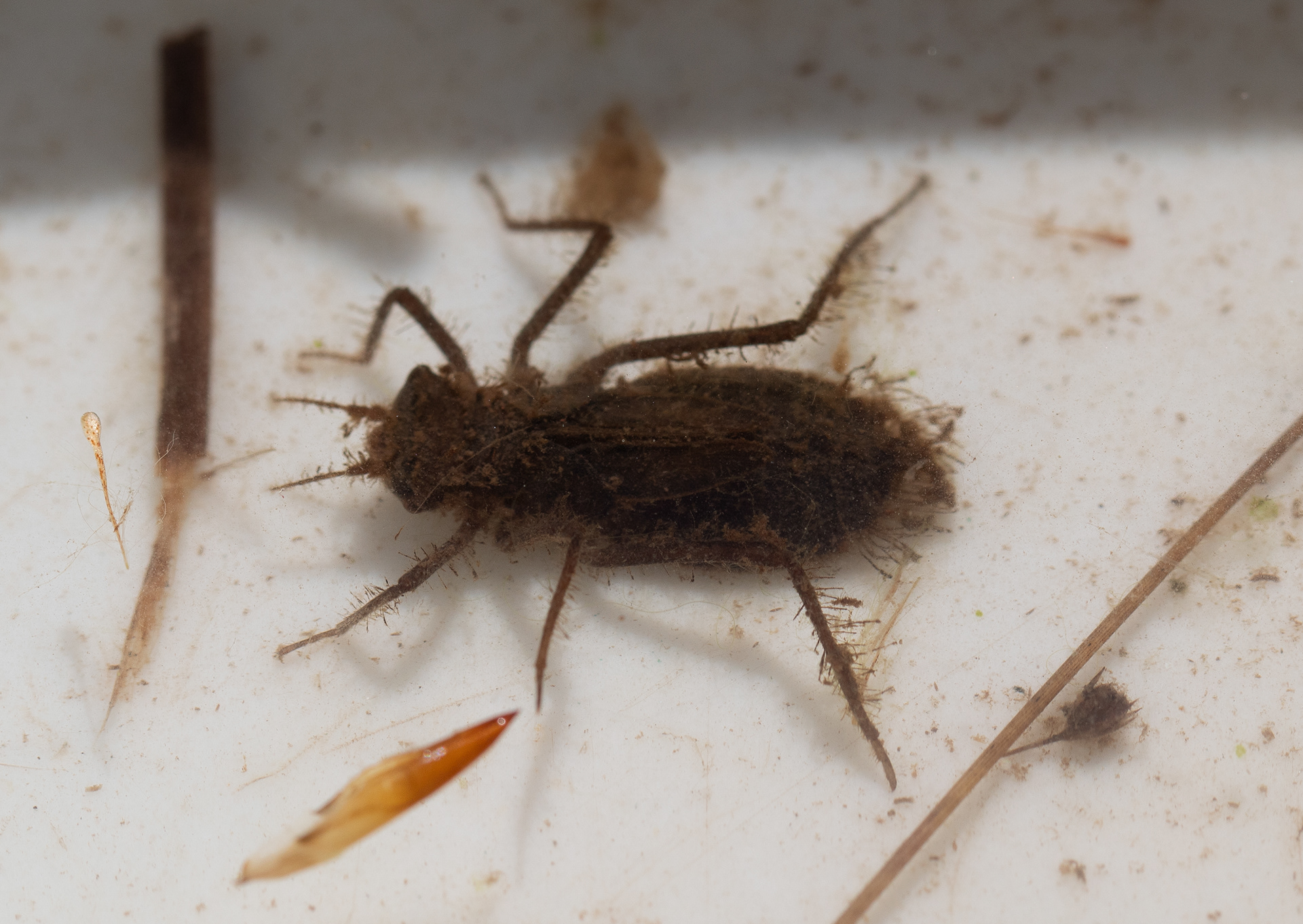
Dennis
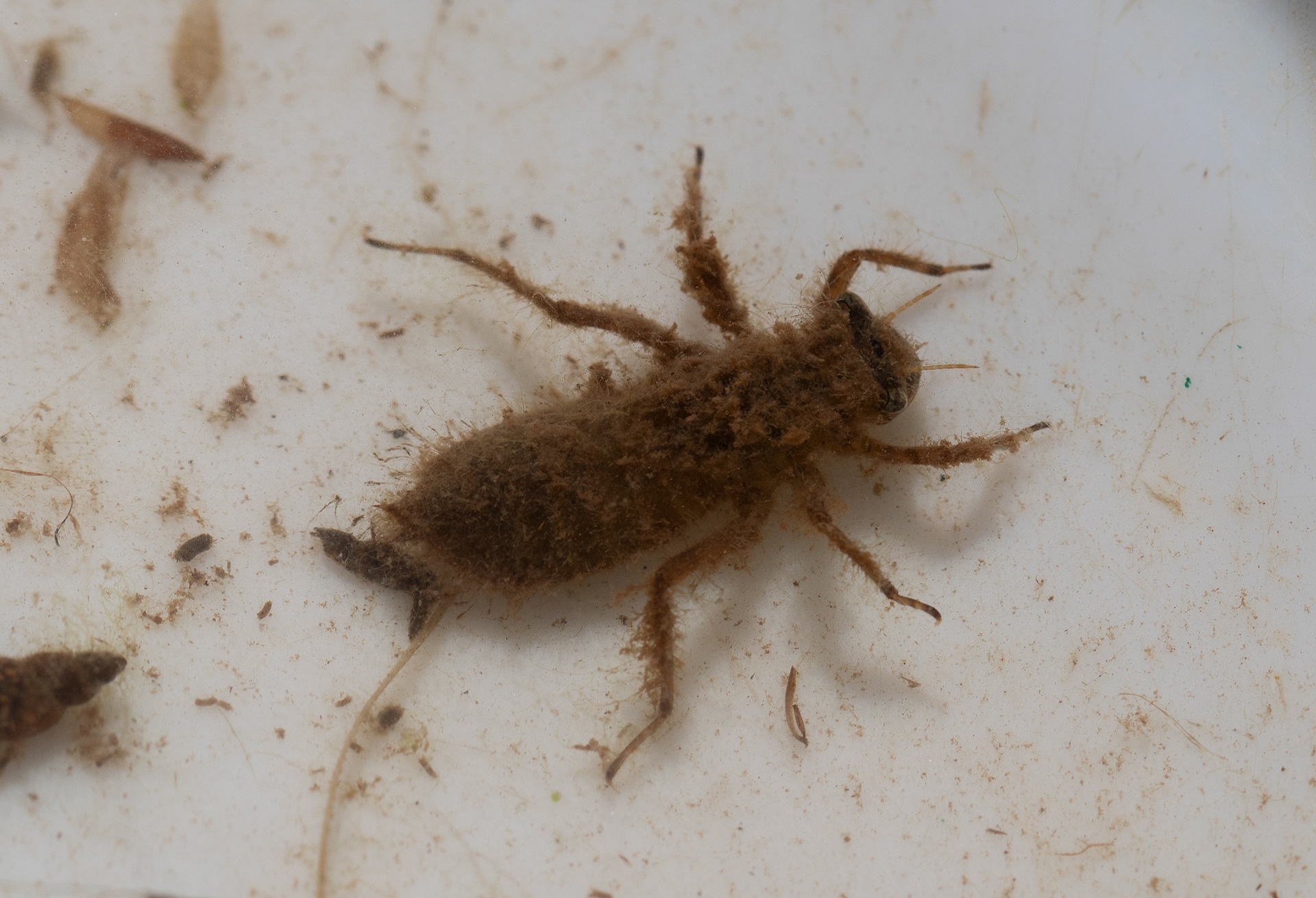
Dragonfly nymph

damselfly nymph

mosquito larvae
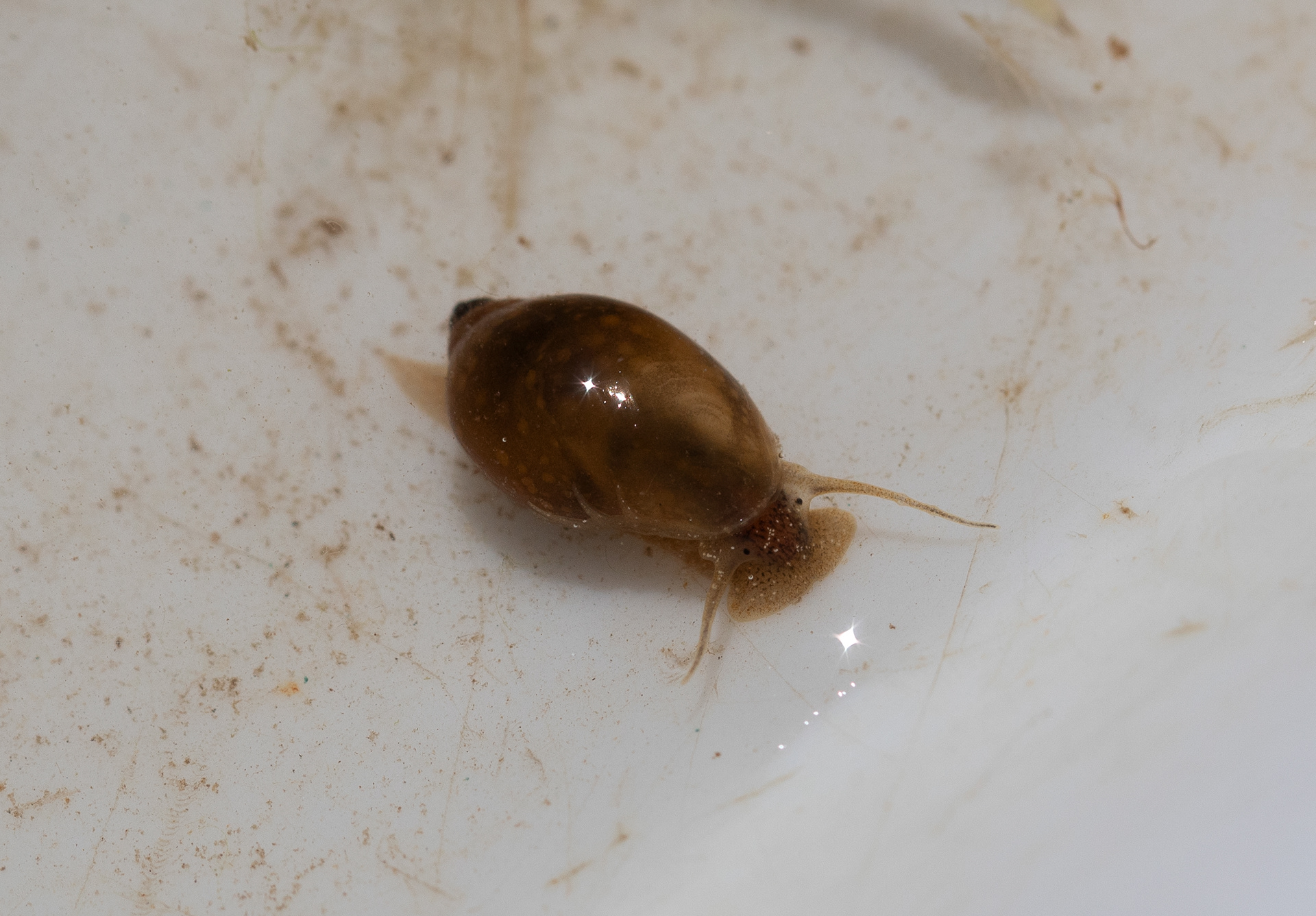
Class Gastropod
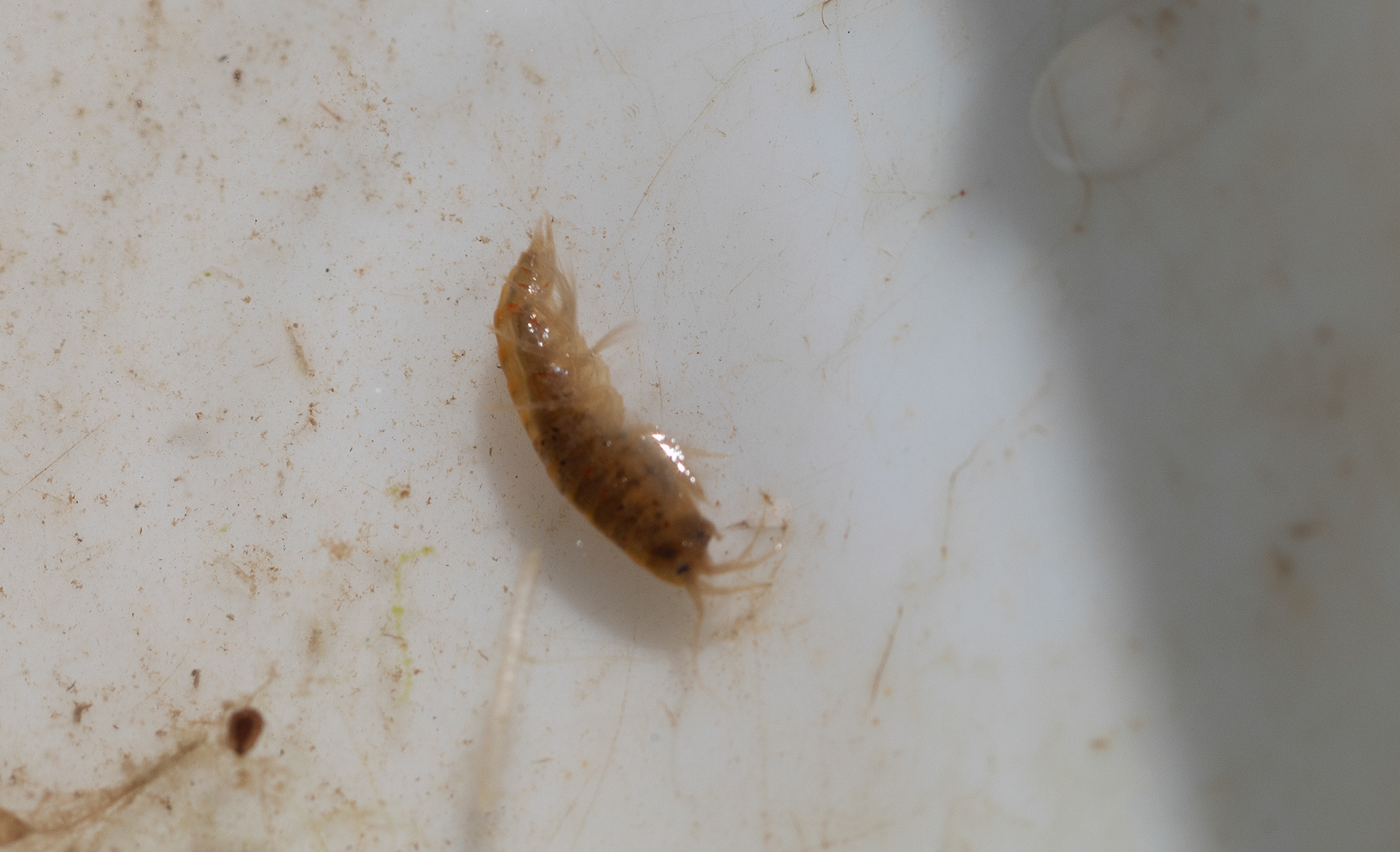
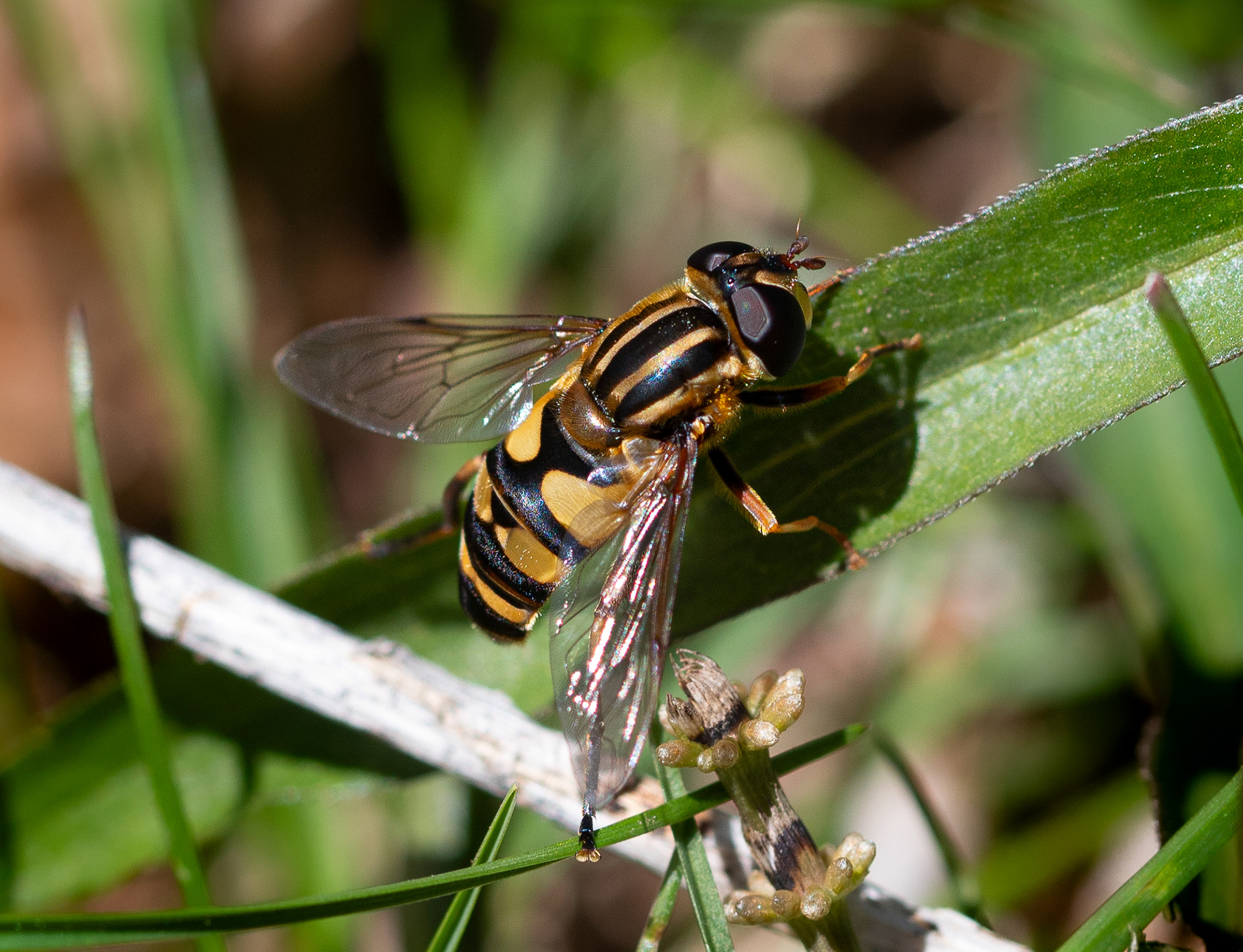
Marsh Flies (Genus Helophilus)
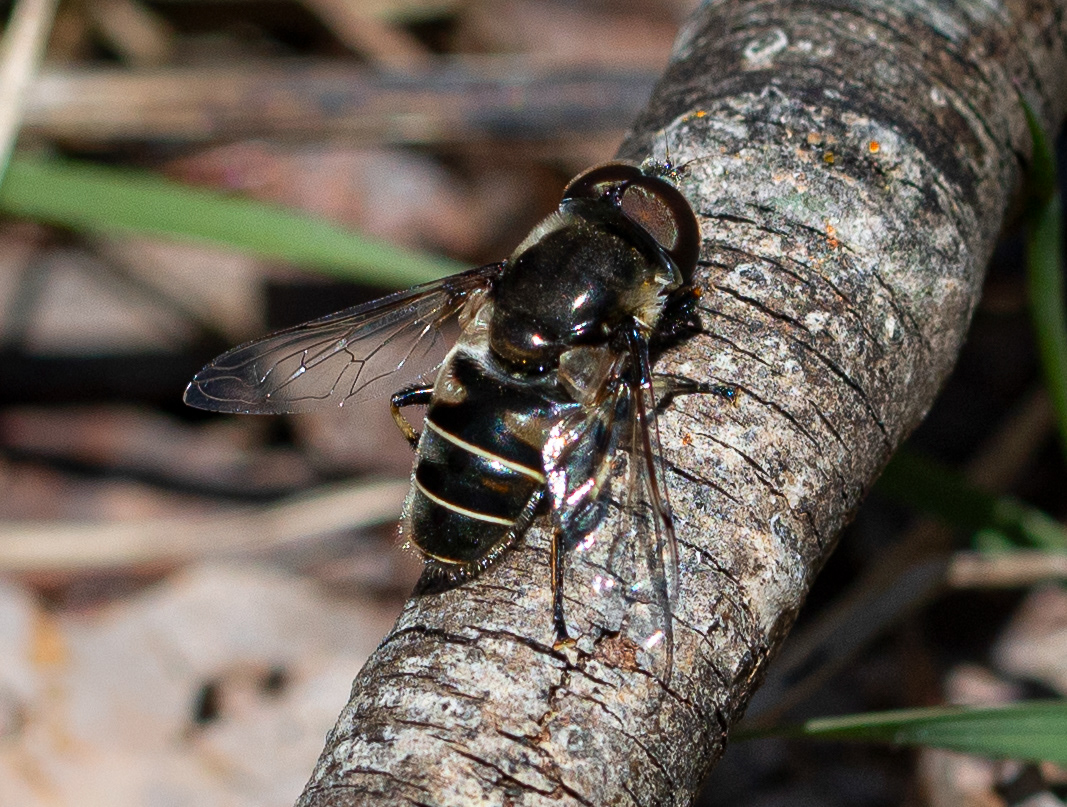
Black-shouldered Drone Fly (Eristalis dimidiata)
Hover flies (family Syrphidae) are in the same taxonomic order as mosquitos. They are important but overlooked pollinator, so named because they pollinate wildflowers and hover when flying.
Species of this family are present throughout the year. They are harmless, despite the stripes, with no ability to sting or bite. If you see them, thank them.
iNaturalist - click to learn more about hover flies
Saturday, May 11th
The first observation of a dragonfly in 2024 was on May 3rd a Common Green Darner (Anax junius). They are a tricky dragonfly to catch and get pictures of, hence a picture and blog post showing up weeks later. Common Green Darners were the first dragonfly to be observed in 2022 on May 23rd and in 2023 was on May 20th. This puts first observation for 2024 roughly 20 days ahead of 2022 and 2023.
People who doubt a Common Green Darner's ability to mock have never tried to catch one, by net, by camera, or by binoculars. Putting all tools of capture out of reach will invite them to fly over, hover eye level, and look curiously at you. This is the most effective way to identify them.
The two pictured are engaging in procreative activities, specifically the mating wheel. More on that here.
Common Green Darners are a relatively well studied dragonfly, in part because some individuals migrate long distances.
Smithsonian magazine article on migration
Monday, May 27th
Emerging Dragons
The Dot-tailed Whiteface is consistently one of the first residents out of the pond. Teneral (immature) individuals are more tricky to identify because species can look similar until adult color patters are present. Several dragonfly species change color patterns over the course of their lives. Dot-tailed Whitefaces lose the yellow dots except the last one and the remainder of the abdomen becomes black.
The Four-spotted Skimmer is distinguished by black and gold on the abdomen, gold on the thorax, and four spots on the wings. In 2021 and 2022 first observation of Four-spotted Skimmers lagged behind Dot-tailed Whitefaces, but in 2023 and 2024 the two species were first observed on the same day.
The unexpected find today was the Stream Cruiser, distinguished by the stripe on the throax. This species likes sandy-bottomed forest streams to breed, which does not describe the pond.
Thursday, June 6th
Today was a bit of magic, rain into the morning, cloudy through the survey. Insects slow down in the cold, to the extent that even busy bees are still. I walked my route and saw dragonflies trying to warm up in the grass and on the ferns, like this clubtail. This was the first clubtail observation of the 2024 field season.
Monarch eggs have a striated pattern and can be found on milkweed leaves. The milkweed is short still, but is able to support monarch eggs.
Saturday, June 8th
This is the dragonfly that started my journey, a male Twelve-spotted Skimmer. The males like to perch high over the pond, a black, white, and blue tapestry of color that draws the eye as they fly through the air. I can only speculate that the females like this splashy color display because the males stick out like a bird snack.
This is one species that distinctly changes color over the course of its lifetime. The male's abdomen gets more white and the white spots on the wings more pronounced. Lighting can cause the white spots to take on a blueish hue.
The female has no white on the abdomen or wings, but looks the same.
Emeralds are a welcome addition to any field season, striking in appearance. This is a Racket-tailed Emerald, named for the racket like structure on the end of the abdomen. For clarity, dragonflies do not have tails, though the abdomen tends to be referred to as a tail in common names.
Monday, June 10
This is Gizmo, a member of the Emerald family and Baskettail genus, species Spiny Baskettail (Epitheca spinigera). Species can not be determined from this pictures, but from the morphology of the sex organs.
I have no explanation for why, but baskettails tend to hang out with me, more than other species, after I catch them. I decided that Gizmo was a good name for them, all of them.
Monday, June 17
This species causes lots of confusion, in partnership with the Twelve-spotted Skimmer, introduced on June 8th. The male Common Whitetail (Plathemis lydia) is pictured on the left and the female on the right. The males of this species, like the Twelve-spotted Skimmer gains white on the abdomen as he matures. Both are members of the Skimmer family, Libellulidae, commonly found in ponds and lakes.
Tuesday, June 25
Genus Meadowhawk (Sympetrum), voted most likely to cause a taxonomist to pull out their hair. This is an example of a White-faced Meadowhawk (Sympetrum obtrusum), however, teneral (immature) individuals do not have their characteristic markings and a handful of species look indistinguishable without studying the sex organs.
Despite their frustrating characteristics, they are a fun group of dragonflies. They like to perch about and fly about eye level on vegetation, making them easy to observe.
Thursday, June 27
This is the clearest pictures I have managed to get of the female Blackbirds prey items. I have located one nest and observed babies in it. I don't stay long because I want to check on the birds, not disturb them. Also, I have had to utilize the trick of putting the net over my head because the male likes to dive bomb my head.
Insects and arachnids are a very important food source for birds to feed their young, which is how pesticide use is contributing to the decline of bird species.
From the picture, I can deduce that the prey item has wings and either two heads or there are two individuals. With that tangled mess of limbs, your guess is as good as mine.
Friday, July 5
Some field days are odd, interesting, chaos, and all the above. I took multiple pictures of things and I have no idea what they were. I was bitten by a couple ants before I realized how close I was to the ground nest. It is exciting to find new things, but it is just as exciting to find a species at about the same time each year, the seasons intact, the world as it should be, an old friend making an appearance.
This is an old friend, red-blue Checkered Beetle (Trichodes nuttalli). It is a beetle and a pollinator. And cute.
This is an old friend that you already met. Common Green Darner. This individual is interesting for a couple reasons. First, it is teneral, possibly newly emerged. This is deduced by the color pattern. I have found exuviae (shed skin) of Darners only in the later part of the year in the pond, which is not true of all locations where this species is found. Furthermore, Darner exuviae are large, easy to see.
Secondly, this is a typical behavior of Darners. I almost stepped on this individual several times before getting this picture. It would pop out of the lower vegetation right in front of me and find a new spot to perch. I would follow, repeat until I managed to track its location and get a picture. Their ability to blend into vegetation, especially in the teneral form, is impressive. The individuals that migrate here in the spring are stronger fliers and tend to fly up higher and settle further away when you spook them.
This familiar face is the first monarch caterpillar of the year. I found eggs still, suggesting they are just starting to hatch. You can see the milkweed sap, a bit, and the chew marks out of the milkweed plant.
This is genus notaclueas. One of the mystery finds. I suspect it is an insect in an early life stage. I have consulted iNaturalist and we will see.
A kind soul on iNaturalist identified this new friend to the suborder level, True Hoppers, Auchenorrhyncha. A member of the True Bugs order, Hemiptera.
This is my first milkweed sap bubble. I thought it was an egg of some kind at first, but milkweed sap is that color and it appears to be coming out of a wound in the plant.
People think of Monarch Butterflies when they think of milkweed, but an entire ecosystem is inspired from the plant.